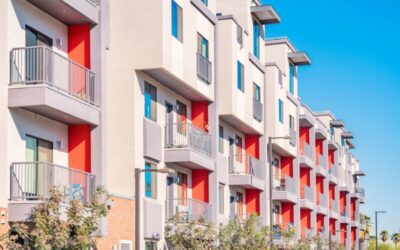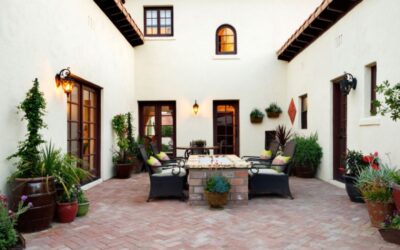The Rise of Southwestern Style
Phoenix, the heart of Arizona, is experiencing a renaissance of Southwestern style. This aesthetic, deeply rooted in the region’s history and culture, is making a powerful comeback in modern homes. Southwestern style is characterized by warm, earthy tones, natural materials, and textures that reflect the desert landscape. Think terracotta, rustic woods, woven textiles, and pottery. It’s a style that embraces the rugged beauty of the desert while offering a sense of warmth and comfort.
But the resurgence of Southwestern style isn’t just about replicating traditional designs. Today’s designers are reinterpreting this aesthetic, blending it with modern elements to create a fresh, contemporary look. This new Southwestern style maintains the warmth and natural appeal of the traditional while incorporating sleek lines, modern furniture, and a minimalist approach that feels right at home in the 21st century.
Phoenix’s Design Identity
While the Southwestern style is a significant part of Phoenix’s design identity, it’s far from the only influence. The city’s design scene is a melting pot, reflecting a diverse range of styles and influences.
Mid-century modern design, for instance, has a strong presence in Phoenix. With its clean lines, functional designs, and a balance of organic and geometric forms, this style perfectly fits the city’s modern, forward-thinking vibe.
Contemporary minimalism is another popular style in Phoenix. This design approach emphasizes simplicity, functionality, and the beauty of open spaces. It’s a style that aligns well with the city’s love for modernity and its appreciation for the stunning natural landscape, which becomes a focal point in minimalist designs.
Phoenix’s design scene also sees influences from Spanish colonial, Mediterranean, and even industrial styles. This diversity is a testament to the city’s dynamic and evolving design scene. It’s a place where tradition meets innovation and where local and global influences come together to create a unique design identity.
In Phoenix, you’re not just finding a style—you’re discovering a design language that speaks to the city’s rich history, vibrant present, and exciting future. Whether you’re drawn to the warmth of the Southwestern style, the sleekness of mid-century modern, or the simplicity of minimalism, Phoenix’s design scene has something to inspire everyone.
Exploring Home Styles Across Phoenix and Beyond
Phoenix and its surrounding cities boast diverse architectural styles, reflecting the area’s rich history, cultural influences, and unique desert environment. Here’s a look at some of the home styles you can find across these vibrant Arizona communities.
Phoenix
In Phoenix, you’ll find a mix of architectural styles that reflect the city’s growth and evolution. Ranch-style homes, popularized in the mid-20th century, are common in many Phoenix neighborhoods. These single-story homes feature open floor plans and a deep connection to the outdoors, a nod to Arizona’s indoor-outdoor lifestyle.
Mid-century modern homes are another staple in Phoenix, thanks to the city’s post-war boom. These homes are known for their clean lines, large windows, and integration with nature.
Phoenix is also home to a number of Spanish Colonial Revival homes, characterized by their stucco walls, red tile roofs, and ornamental details like arches and courtyards.
Scottsdale
Scottsdale’s architectural landscape is heavily influenced by its desert surroundings. The city is known for its Pueblo Revival homes, which draw inspiration from the area’s original Pueblo Indian structures. These homes feature earthy materials, flat roofs, and rounded exteriors that mimic the desert’s natural contours.
Scottsdale is also home to a number of contemporary homes that blend modern design principles with a sensitivity to the desert environment. These homes often feature sustainable materials, energy-efficient designs, and a seamless blend of indoor and outdoor spaces.
Paradise Valley
Paradise Valley, known for its luxury homes and beautiful landscapes, showcases a variety of architectural styles. Mediterranean-style homes are quite popular, characterized by their stucco walls, tiled roofs, and grand outdoor spaces that take advantage of the area’s stunning views.
You’ll also find a number of modern and contemporary homes in Paradise Valley featuring sleek lines, expansive glass, and minimalist aesthetics. These homes are designed to blend with the area’s natural beauty, offering panoramic views of the desert and mountains.
Tempe
In Tempe, you’ll find a mix of old and new. Historic neighborhoods offer charming Tudor and Colonial Revival homes, while newer areas feature contemporary and ranch-style homes. The city’s proximity to Arizona State University also means a variety of condos and townhomes catering to students and faculty.
East Valley: Mesa, Chandler, and Gilbert
The East Valley cities of Mesa, Chandler, and Gilbert offer a range of home styles, from traditional to contemporary. Ranch-style homes are common, particularly in Mesa and Gilbert, reflecting the area’s post-war growth.
In Chandler, you’ll find a mix of styles, from Mediterranean and Spanish Revival homes to more modern designs. The city’s Ocotillo area is known for its luxury waterfront homes.
Gilbert, meanwhile, is known for its family-friendly homes, many of which feature popular styles like ranch, Craftsman, and contemporary. The city’s Agritopia neighborhood is notable for its modern farmhouse-style homes.
In all these cities, there’s a growing trend towards sustainable design, with many new homes featuring energy-efficient designs and eco-friendly materials.
Navigating the Interior Design Landscape in Phoenix
The Pioneers: Established Design Firms
Phoenix is home to a number of established design firms that have been shaping the city’s aesthetic for years. These firms are known for their experience, extensive portfolios, and their ability to deliver a wide range of styles. They have a deep understanding of the local culture and environment, and they use this knowledge to create beautiful and functional designs.
The Innovators: Up-and-Coming Designers
The design scene in Phoenix is constantly evolving, thanks to a new wave of up-and-coming designers. These innovators are not afraid to push boundaries and experiment with new ideas. They bring fresh perspectives and are often well-versed in the latest design trends. Whether they’re working independently or as part of a small studio, these designers are making their mark on Phoenix’s design landscape.
The Specialists: Niche Design Experts
In the world of interior design, specialization can be key. Some designers in Phoenix have carved out a niche for themselves by focusing on specific styles or spaces. For instance, you might find designers specializing in Southwestern style, mid-century modern, minimalist, or sustainable design. Similarly, some designers might focus on specific rooms like kitchens, bathrooms, or outdoor living spaces. These specialists have a deep understanding of their chosen niche and can provide expert guidance for those specific projects.
Freelance Designers vs. Design Firms
When looking for an interior designer in Phoenix, you’ll come across both freelance designers and design firms. Freelance designers often offer more personalized service and the opportunity for a close working relationship. On the other hand, design firms typically have a team of designers and access to a wider range of resources. The choice between a freelance designer and a design firm will depend on the scope of your project, your budget, and your personal preference.
The New Wave: Online Interior Design Services
The digital age has brought a new player to the field: online interior design services. These platforms connect clients with designers from all over the country, offering a convenient and often more affordable option. While this option lacks the local touch, it can be a great choice for those comfortable with virtual collaboration.
Remember, the best designer for your project will depend on your personal style, the scope of your project, and your budget. Take the time to explore different options and meet with potential designers to find the perfect fit for your needs.
Hiring an Interior Designer in Phoenix
What to Look For
Hiring an interior designer is a significant decision that can greatly impact the look and feel of your home. Here are some key factors to consider when choosing the right designer for your project:
Experience and Expertise: Look for a designer with experience in the type of project you’re planning. If you’re remodeling a kitchen, for example, you’ll want a designer specializing in kitchens. Similarly, if you’re drawn to a specific style, such as Southwestern or mid-century modern, look for a designer with expertise in that area.
Portfolio: A designer’s portfolio is a window into their style and capabilities. Review their past work to see if it aligns with your vision. Look for diversity in their designs, attention to detail, and how they use space and color.
Client Reviews and References: Client reviews can provide valuable insights into a designer’s work ethic, reliability, and communication style. Don’t hesitate to ask for references and reach out to past clients.
Budget and Pricing Structure: Designers can charge in various ways, including a flat fee, an hourly rate, or a percentage of the project cost. Ensure you understand their pricing structure and that it fits within your budget.
Compatibility: You’ll be working closely with your designer, so it’s important to choose someone you feel comfortable with. Look for a designer who listens to your ideas, understands your vision, and communicates clearly.
Questions to Ask
Before you sign a contract, make sure you ask these essential questions:
- What is your design process? Understanding the process will help you know what to expect and ensure a smooth collaboration.
- How do you handle budgets and timelines? It’s important to know how the designer manages the budget and whether they can complete the project within your desired timeline.
- Can you work with my existing furniture and decor? If you want to incorporate existing pieces into the design, ensure the designer is comfortable with this.
- How do you handle purchasing? Some designers prefer to handle all the purchasing, while others may involve you in the process.
- What happens if I’m not happy with a design choice? It’s important to know how the designer handles changes or disagreements in the design process.
- Can you provide 3D renderings or samples? These can help you visualize the final design and make decisions about materials and colors.
Remember, the goal is to find a designer who understands your vision, can work within your budget and timeline, and with whom you feel comfortable collaborating. With the right preparation and questions, you’ll be well on your way to finding the perfect interior designer for your Phoenix home.
Real Estate and Interior Design
The Impact of Design on Property Value
Good design is about more than just creating a beautiful space—it’s also a strategic investment that can significantly boost your property’s value. In Phoenix, where the real estate market is competitive, a well-designed home can be a game-changer.
Good design enhances the functionality of your home. By optimizing the layout, improving lighting, and choosing the right materials, a skilled interior designer can transform your space into a more comfortable and efficient place to live. This functional appeal can be a major selling point for potential buyers.
Secondly, interior design can enhance the aesthetic appeal of your home. A well-designed home can create a powerful first impression, evoke positive emotions, and help your property stand out in the market. Whether it’s a sleek modern look, a cozy Southwestern vibe, or a blend of styles that reflects Phoenix’s diverse design scene, a beautifully designed home can attract more buyers and command a higher price.
Lastly, a well-designed home can also appeal to buyers on a deeper emotional level. A home isn’t just a building—it’s a place where people build their lives. A designer can help create a great space that feels welcoming and homely. This emotional appeal can be a powerful factor in a buyer’s decision-making process.
Staging Homes for Sale
If you plan to sell your home, staging can be a powerful tool to attract buyers and secure the best sale price. Staging involves arranging furniture and decor to showcase your home’s best features and help potential buyers visualize themselves living there.
In Phoenix, top interior designers approach home staging as an art. They understand the local market and what Phoenix buyers are looking for. They use design techniques to highlight your home’s strengths, downplay its weaknesses, and appeal to the widest possible audience.
For instance, they might use furniture to define ambiguous spaces, create a sense of flow, or make a small room feel larger. They might use decor to add warmth to a sterile space or neutralize a too-personal color scheme. They understand how to use lighting to create a welcoming atmosphere and how to arrange outdoor spaces to highlight the potential for Arizona’s indoor-outdoor living.
Remember, the goal of staging is not just to make your home look beautiful but to help buyers see its potential and imagine themselves living there. With the right staging, your home can make a powerful first impression, stand out in the Phoenix real estate market, and sell more quickly and for a higher price.
Interior Design for Arizona Living
Designing for the Desert
Living in Arizona presents a unique set of design considerations. The desert environment, with its intense heat and dramatic temperature swings, requires a thoughtful approach to interior design.
One of the key considerations is the choice of materials. Materials that can withstand heat, resist sun damage, and help keep the interior cool are essential. Natural materials like stone and tile are popular choices for flooring as they stay cool underfoot. Light-colored materials, which reflect rather than absorb heat, are also a smart choice for both interiors and exteriors.
Creating shade and airflow is another important aspect of desert design. Window coverings can help block out the intense Arizona sun, while ceiling fans and strategically placed vents can promote airflow and help cool down interior spaces.
Incorporating elements of the desert into the design can also help create a sense of harmony with the environment. This could mean using a color palette inspired by the desert landscape, incorporating cacti and other native plants into your decor, or using large windows to highlight desert views.
Sustainable Design in Phoenix
Sustainability is a major focus in the world of interior design, and Phoenix is no exception. Local designers are increasingly incorporating eco-friendly practices and materials into their work, driven by both environmental considerations and growing demand from clients.
This can involve using recycled, sustainably sourced materials or low in volatile organic compounds (VOCs). It can also mean designing homes to be more energy-efficient, for example, by optimizing natural light, improving insulation, or installing energy-efficient appliances.
Water conservation is another key aspect of sustainable design in Phoenix, given the arid climate. This can involve everything from installing low-flow fixtures to designing landscapes that require minimal irrigation.
Sustainable design is not just about being kind to the environment—it can also create healthier and more comfortable living spaces. And with a growing range of eco-friendly products and technologies available, it’s an exciting time to explore sustainable design in Phoenix.
Frequently Asked Questions
Understanding Interior Design
What does an interior designer do? An interior designer is a professional who creates functional and aesthetically pleasing indoor spaces. They consider various elements such as color, lighting, layout, and furniture, and they use these elements to enhance the functionality and overall look of the space. They also take into account safety and building codes.
What is the difference between an interior decorator and an interior designer? While these terms are often used interchangeably, there is a difference. Interior designers typically handle more complex tasks that may involve structural changes, space planning, and technical aspects like lighting and acoustics. They often have formal education in the field and may be required to be licensed or certified. Interior decorators, on the other hand, focus more on aesthetics, such as color schemes, furniture, and decor. They don’t usually engage in renovations or structural planning.
Hiring an Interior Designer
How do I find an interior designer I like? Start by researching local designers in your area and reviewing their portfolios. Look for a designer whose style resonates with you. You can also ask friends, family, or professional contacts for recommendations. Once you have a shortlist, arrange consultations to discuss your project and see if you feel comfortable with them.
What you should know before hiring an interior designer? Before hiring an interior designer, it’s important to have a clear idea of your budget, timeline, and what you hope to achieve with the project. You should also familiarize yourself with the designer’s portfolio, pricing structure, and process. Don’t hesitate to ask for references, and make sure you feel comfortable communicating with them.
How do I talk to an interior designer? Be open and honest about your expectations, including your budget, timeline, and the look and feel you want for your space. Don’t be afraid to ask questions or share your ideas. Good communication is key to a successful design project.
What should interior designers ask clients? Interior designers should ask clients about their lifestyles, preferences, and the function of the space. They might ask about your favorite colors, how you plan to use the space, what you like and dislike about the current space, and any specific ideas or inspirations you have.
Cost and Value of Interior Design
Is interior design expensive? The cost of interior design can vary greatly depending on the scope of the project, the designer’s experience and fee structure, and the materials and furnishings used. Some designers charge an hourly rate, while others charge a flat fee or a percentage of the project cost.
Do interior designers charge up front? Some interior designers require a retainer or deposit up front, which is typically a percentage of the total estimated design cost. The rest of the fees are usually billed as the project progresses, but this can vary depending on the designer’s payment policy.
What does interior design cost include? Interior design costs typically include the designer’s fee for their time and expertise. It may also include the cost of furniture and materials, contractor fees if remodeling is involved, and possibly a markup on the designer’s products or services.
Do interior designers mark up products? Some interior designers mark up products they purchase on behalf of their clients. This is a common practice and should be outlined in the contract. However, even with the markup, designers often have access to trade discounts that can make furnishings and materials more affordable than retail prices.
How to save money on interior design? To save money on interior design, you can set a clear budget and communicate it to your designer, choose a designer who charges in a way that suits your budget, or consider online design services, which can be more affordable. You can also use a designer for consultation or planning and do some of the purchasing and implementation yourself.
Why is hiring an interior designer worth it? Hiring an interior designer can add value to your project in several ways. They can help you avoid costly mistakes, access a wider range of resources, provide a professional assessment of your space, and manage the project. A well-designed space can also enhance your quality of life and potentially increase the value of your home.
Understanding the Design Process
What is the downside of interior design? While interior design can transform a space and enhance your home, it can also be a significant investment of time and money. It may involve making difficult decisions and dealing with disruptions if major renovations are involved. However, a good designer will help manage these challenges.
What are the pros and cons of an interior designer? Pros of hiring an interior designer include their expertise in creating functional and beautiful spaces, access to resources and tradespeople, and potential cost savings from avoiding mistakes. Cons can include the cost of hiring a designer, potential disagreements over design choices, and the time it can take to complete a project.
How to negotiate with an interior decorator? When negotiating with an interior decorator, be clear about your budget and expectations. Ask about their fee structure and what services are included. If their initial quote is too high, ask if there are areas where costs could be reduced or consider reducing the scope of the project.
What is the 70-30 rule in interior design? The 70-30 rule in interior design suggests that 70% of a room should be in a dominant color, 30% in a secondary color. This rule helps create a balanced, harmonious color scheme.
Why are interior designers so expensive? Interior designers bring a wealth of knowledge and expertise to a project, which is reflected in their fees. They spend years studying and training in their field. The cost of an interior designer also includes the time they spend researching, planning, coordinating with contractors, and sourcing materials and furnishings.
Related: Arizona Home Improvement Guide











